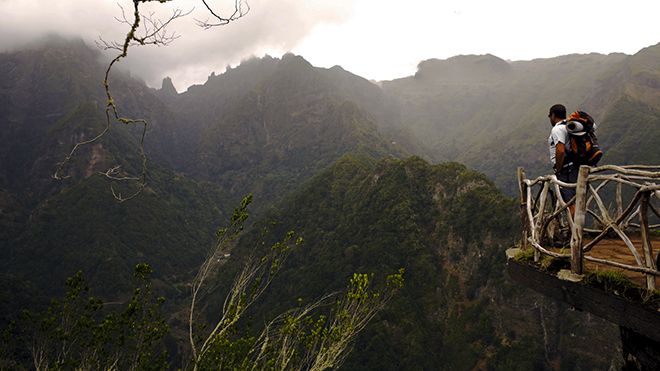Parque Natural da Madeira

Protected Areas
This archipelago part of the Macaronesian biogeographical region contains a natural heritage of extreme scientific importance: the native forest of Madeira (Laurissilva), which was recognised by UNESCO in 1999 as World Natural Heritage, a unique distinction in Portugal, and now the bio-cultural property of all humankind.
Madeira has the largest area of this type of forest, about 22,000 hectares, and also the greatest variety of flora and fauna, with some rare species such as the Orquídea da Serra (Mountain Orchid), unique in the world.Here you can see large trees belonging to the Lauraceae family - the Madeira laurel, the bay tree, and the Madeira mahogany, as well as shrubs, ferns, moss, lichens and other small plants typical of the Laurissilva forest.
Amongst the bird life is the endemic Madeiran wood pigeon, the Columba trocaz, an emblematic forest bird and the symbol of the Madeira Natural Park.
Two-thirds of Madeira’s 741km2 is classified as a nature reserve and a number of protected land and sea areas are part of the most important natural heritage of the Madeira archipelago, making it a prime ecological destination.
The Madeira Natural Park was created in 1982 to preserve this rich heritage. The park is classified as a Biogenetic Reserve and contains an invaluable natural wealth that is unique in the world and includes some endangered species. The best way to visit the Park is on foot along the network of recommended trails.
The Desertas Islands Natural Reserve comprises three islands: Ilhéu Chão, Deserta Grande and Bugio. It is the last Atlantic sanctuary for the monk seal (Monachus monachus), better known locally as the wolf fish, which was the main reason for its creation. The measures imposed for the preservation of the reserve include a complete ban on underwater fishing and sailing in its southern part. To moor a boat or visit Deserta Grande, you need to obtain a licence from the Madeira Natural Park Services. Access is by sea on private or maritime tourist vessels.
At the Southern tip of the territory, the Selvagens Islands Natural Reserve is considered a “bird sanctuary” due to the conditions it offers for sea birds to nest. It comprises three islands: Selvagem Grande, Selvagem Pequena and Ilhéu de Fora. Herbivores were never introduced on Selvagem Pequena or Ilhéu de For a, so of the ninety species that compose the floral heritage of the Selvagens, ten are endemic. Access to the reserve is by sea on private or maritime tourist vessels, although it is only permitted when duly authorised and licensed by the Madeira Natural Park Services.
The Marine Nature Reserve of Garajau, on the Southern coast of the Island of Madeira, is considered a marine reserve. Amongst its fauna, in addition to a number of other coastal species, are some large fish such as the dusky sea perch (Epinephalus guaza), the manta ray and the giant devil ray (Manta birostris Mobula mobular), whose size and graceful movements make the site an international attraction. The docility of the fish, which are used to divers, allows you to swim amongst them and the opportunities for underwater photography are excellent. Fishing is banned inside the reserve and sailing is also restricted. Access is by land via Cais do Lazareto or Garajau Beach.
The Rocha do Navio Nature Reserve is located in the North of the Island of Madeira, in the municipality of Santana, and is part of the Natura 2000 Network. It is an exclusively marine reserve which comprises Ilhéu da Rocha das Vinhas and Ilhéu da Viúva, where you can observe certain plants typical of the Macaronesian natural cliffs. Access is via the Miradouro da Rocha do Navio or by cable-car. Spearfishing and the use of nets is banned. There is an environmental education programme of visits to the Reserve, which can be booked through the Park Services Information Centre (SPNM).
On the Eastern tip of the Island of Madeira, you will find the Ponta de S. Lourenço Nature Reserve, with its own flora and fauna, where there is a monitoring and environmental education post.
The Porto Santo Protected Marine Areas Network comprises the land parts of the six islets surrounding the Island and the sea part around Ilhéu da Cal and Ilhéu de Cima, including the area where the Madeirense shipwreck provides an exceptional location for diving. The whole of the land part is a Special Preservation Area included in the Natura 2000 Network. Access is by sea, by private or maritime tourist vessels, and is only permitted when duly authorised and licensed by the Madeira Natural Park Services (SPNM).
The Dragoeiros das Neves Centre located in São Gonçalo and comprising a group of century-old dragon blood palms and a garden with native vegetation from the Madeiran coast is also notable.
Since 2011, in recognition of the richness of an ecosystem that seeks to reconcile the preservation of biodiversity and its sustainable use, Unesco classified the whole Madeira Natural Park area in the municipality of Santana as a World Biosphere Reserve.
For more information on Madeira’s protected areas habitats and species please visit the Madeira Natural Park’s website.









 Explore
Explore 
 Remember and Share
Remember and Share 


